Several UBC Biology faculty are using creative ways to engage students as they join synchronous class sessions. For some examples, check out Celeste Leander’s recent blog post and keep reading to learn how Karen Smith, Greg Bole, Angie O’Neill, Rachel Wilson, and Kathryn Zeiler are using pre-class activities to engage students in their courses.
Karen Smith (BIOL 112):
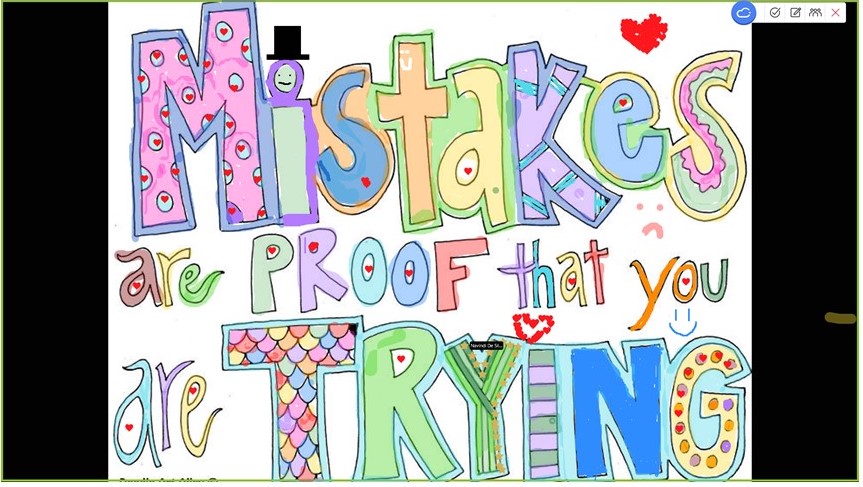
What types of activities do you offer students as they are joining your class session?
I use colouring pages. I chose a variety of examples such as cells, proteins, science & research, but also messaging such as “Black Lives Matter”, and “Mistakes mean you are trying” (example colouring pages below).

What prompted you to include these activities in your class sessions?
There are 270 students in the lecture and I start the zoom class link 15 – 20 minutes early. During that time, I try to encourage questions and discussions. As it is a 9 am class, initially I found the students not very responsive. I decided that I wanted to be doing something to ease them into the day/class. I found it useful as I could then use the messaging or the image to ease into important topics for that day.
How have the students responded to these activities?
As soon as a colouring page is shared, students are right into it! When I tried to engage them by doing other things like writing comments, there was less involvement. I also post these images into my post-class slides so they can see their work again!
What impact have these pre-class activities had on your course?
I am trying to use these activities to begin to build community in a large class. Students appeared to be more relaxed and less anxious about the class. Especially for first year students – it is unexpected – colouring in a university science class? When I refer to the image as they colour, I found that more students turned on their cameras and started to talk openly. Even if they were not colouring, the image started a conversation.
What advice do you have for other instructors who are interested in using a similar activity in their own course?
- Pick an image that relates to the course or a topic you want to introduce such as content, wellbeing, midterm anxiety , social justice topics. It feels more natural, easier, to segue into trickier topics.
- Try to do some colouring yourself. I always start on the image as no one wants to be the first one to dive in. But I am definitely not as good as them!
- Some images are too detailed – and some too simplistic. Too detailed is difficult to colour successfully and they give up. If you have a simple image then use add in more than one. For a recent DNA lecture, the DNA helix was very simple but also added an antibody because Trump had just received antibody therapy. It allowed me to refer to the protein lecture we just covered and the new content, DNA.
- Be sure to save the colouring page by the annotation tool. This gets saved to a zoom folder so you can post the image later.
Is there anything else you’d like to share?
I will see by the end of the term if they get tired of them. So far, I have a hard time stopping the colouring so I can start the class!
Greg Bole (BIOL 121):

What types of activities do you offer students as they are joining your class session?
I start every class with a page from an animal colouring book. I searched the web for cool fair-use examples and found quite a few. My only criteria is that they are non-domesticated animals and I also try to get as wide a range of kinds of animals as possible (vertebrates, invertebrates, terrestrial, aquatic, etc.) I even found a Kiwi and a Tuatara!
What prompted you to include these activities in your class sessions?
At first I wanted students to practice using the annotation tool at the start of the term. That way I could use it during the lecture as needed and students would already know how to use it. But I also really enjoy how it starts every class on a positive and creative note. Sometimes I am even able to incorporate the animal they were colouring into the day’s topic.
How have the students responded to these activities?
Quite a few of them really enjoy it. It’s hard for me to tell how many out of the 236 students are engaged in the colouring or drawing, but it is many. They also like to draw fun little doodles and sometimes add small messages in text, usually Biology jokes or puns.
What impact have these pre-class activities had on your course?
I think it helps the students unwind a little before class and also hopefully builds a bit of community. I also have a subset of students who use their cameras during the lecture in Zoom (I so appreciate being able to talk to real people!) and they have started coordinating their Zoom backgrounds with fun things like memes or funny references.

What advice do you have for other instructors who are interested in using a similar activity in their own course?
It’s super easy to implement and lots of fun. But you do have to watch out for a small minority of students who want to disrupt or troll the activity, usually by scribbling over the image or writing inappropriate text. I have been able to keep it under control by both negative feedback (using the clear or eraser buttons, in extreme cases disabling annotations) and positive feedback (I comment on the drawings and doodles as well as the colouring). Once I even let everyone go crazy with scribbling for the last 30 seconds. It was such beautiful chaos!
Is there anything else you’d like to share?
Colouring is a low stakes way to get students ready to be engaged and help the release some of their stress or anxiety. It does seem to be building community in a large class and is a lot of fun. I also like to share their creations with them on the after-lecture slides that I post.
Angie O’Neill (BIOL 204):
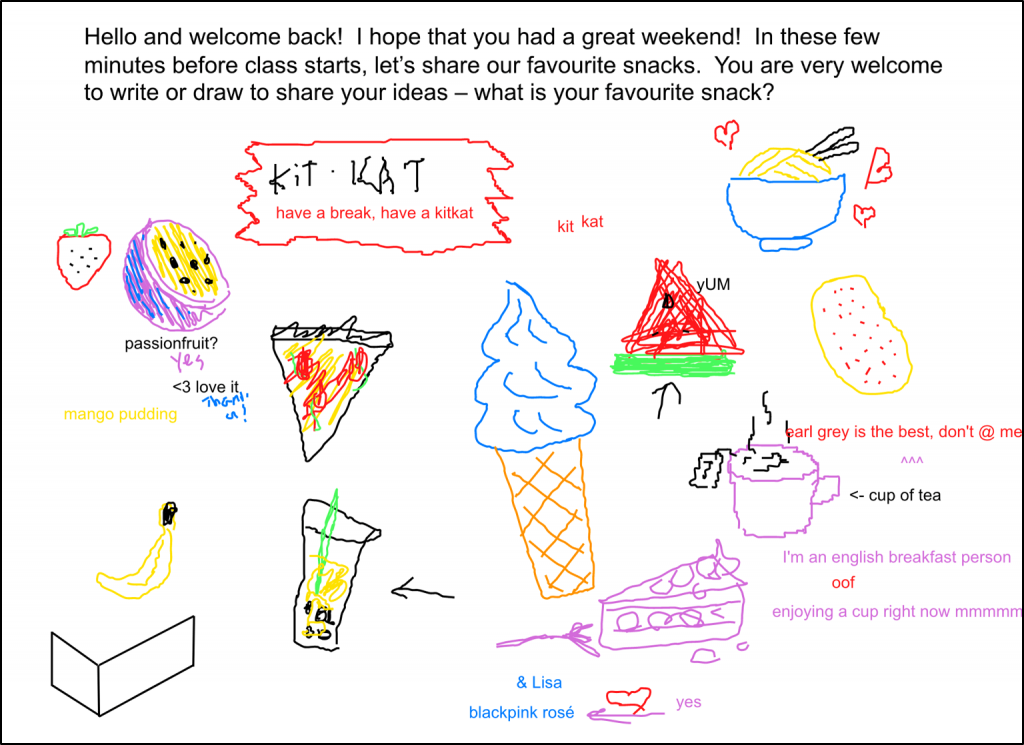
What types of activities do you offer students as they are joining your class session?
Some days in the 5 minutes before class starts I ask students a question, such as “what is your favourite snack?” or “what is your favourite movie or show?” and encourage them to share by annotating the slide, either by typing or drawing. Other days, I give students an image to colour, with lots of blank space surrounding it so that they have the option to draw their own pictures too.
About halfway through the term, I gave students the following question:
“Hello and welcome back! Studying can be stressful, and the pandemic is certainly stressful too. In these few minutes before class starts, let’s share ideas for things to do to decrease stress and increase wellness. You are very welcome to write or draw to share your ideas – what is something you do that helps you to feel less stressed?”
When I posted the material for that lecture after class, I included a list of all the activities that students recommended for stress reduction, as well as links to several UBC resources for stress management and counseling (slide below).
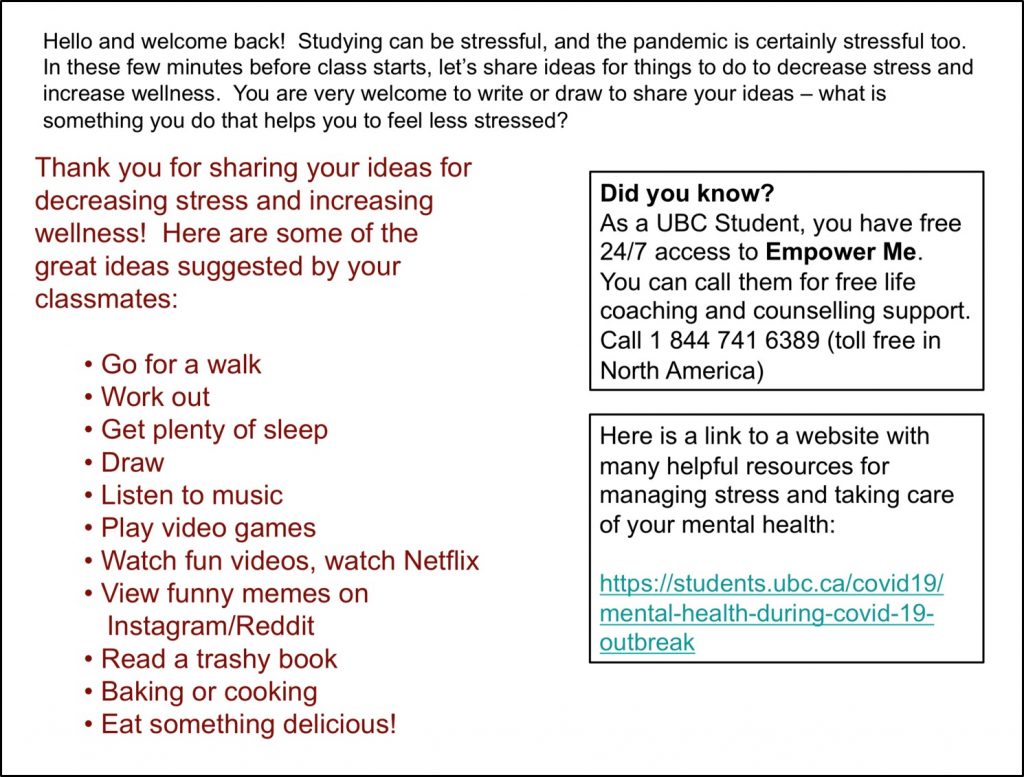
What prompted you to include these activities in your class sessions?
I was looking for a way to build community in an online class, to make students feel welcome and give them a chance to share with me and one another. I wanted to give students a fun activity to get them warmed up to participate in the synchronous classes. For the activity where I asked students to share ideas for wellness and reducing stress, I wanted to get students thinking about how to reduce their stress and look after themselves during a particularly stressful time of the term.
How have the students responded to these activities?
The students seemed to enjoy these activities. Many students participated with enthusiasm. I did not ask about these pre-class activities in my exit survey for my summer class of BIOL 204, so unfortunately I don’t have any solid data on the percentage of students who enjoyed these activities.
What impact have these pre-class activities had on your course?
Unfortunately I have no evidence to answer this question. I did not ask about these activities in my exit survey, and students did not really mention them in my teaching evaluations. I hope that these activities helped to get students warmed up for participating in class, and that they helped students to feel like part of a community, but I really don’t know whether or not they had much of an impact.
Rachel Wilson (BIOL 230):
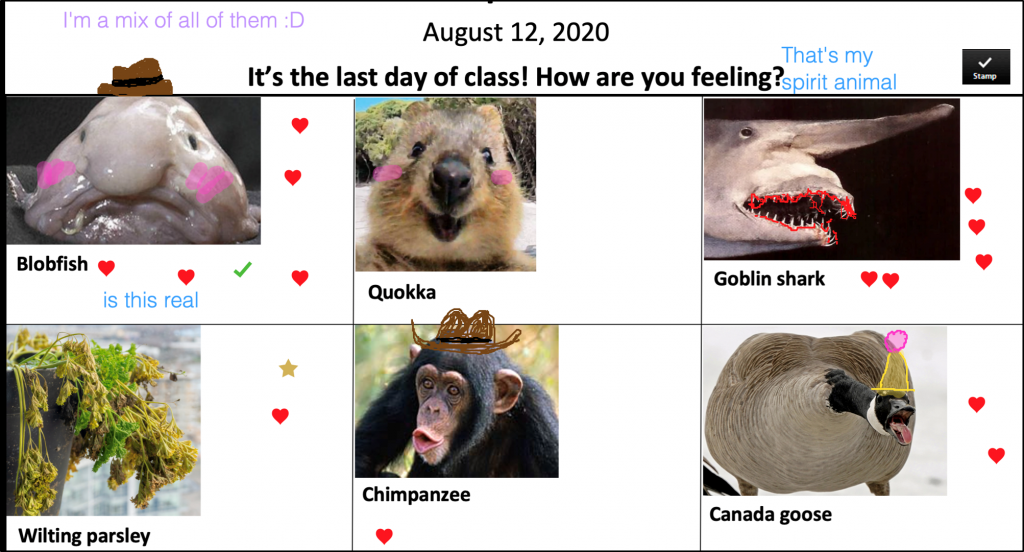
What types of activities do you offer students as they are joining your class session?
- “Organism of the day” featuring photos, fun facts, and often a personal anecdote.
- Black and white cartoons for colouring in; I especially enjoyed half-finished cartoons so that students could get really creative (and weird – see attachments)
- Just-for-fun opinion polls, e.g. “Who would win in a fight – 1 hippo, 5 cassowaries, or 50 Canada geese? Stamp your choice.”
- Wellbeing check-ins, e.g. “Stamp next to the animal that best represents your feelings about Midterm 1.”
- Stamping a map of the world & greater Vancouver area to indicate current (approximate) location – this was done in the very first class
What prompted you to include these activities in your class sessions?
It seemed like a good way to build community in the course, fill the awkward dead air before the start of class, and engage the students without putting pressure on them.
How have the students responded to these activities?
Very positively. The activities were great icebreakers, often triggering commentary/discussion in the chat. I think the activities also helped students realize that we are not only here to teach, we’re here to get to know the students and even have fun with them.
What impact have these pre-class activities had on your course?
The more humorous activities were great for building community and rapport. I think everyone has been feeling higher levels of stress and loneliness, so it felt wonderful to simply have a laugh with students. The fill-in colouring activities were relaxing and calming (particularly nice on a Monday morning), while the finish-the-drawing activities were a chance for students to flex their creative skills. Overall, the activities were a fun way for students to connect with their peers & instructors in a no-pressure setting.
What advice do you have for other instructors who are interested in using a similar activity in their own course?
You have nothing to lose – go for it! Get creative! Just make sure you start the class a few minutes early so that students have time to contribute. I actually enjoyed these activities so much that I’d be motivated to find a way to incorporate them into my in-person lecturing.
Kathryn Zeiler (BIOL 112):
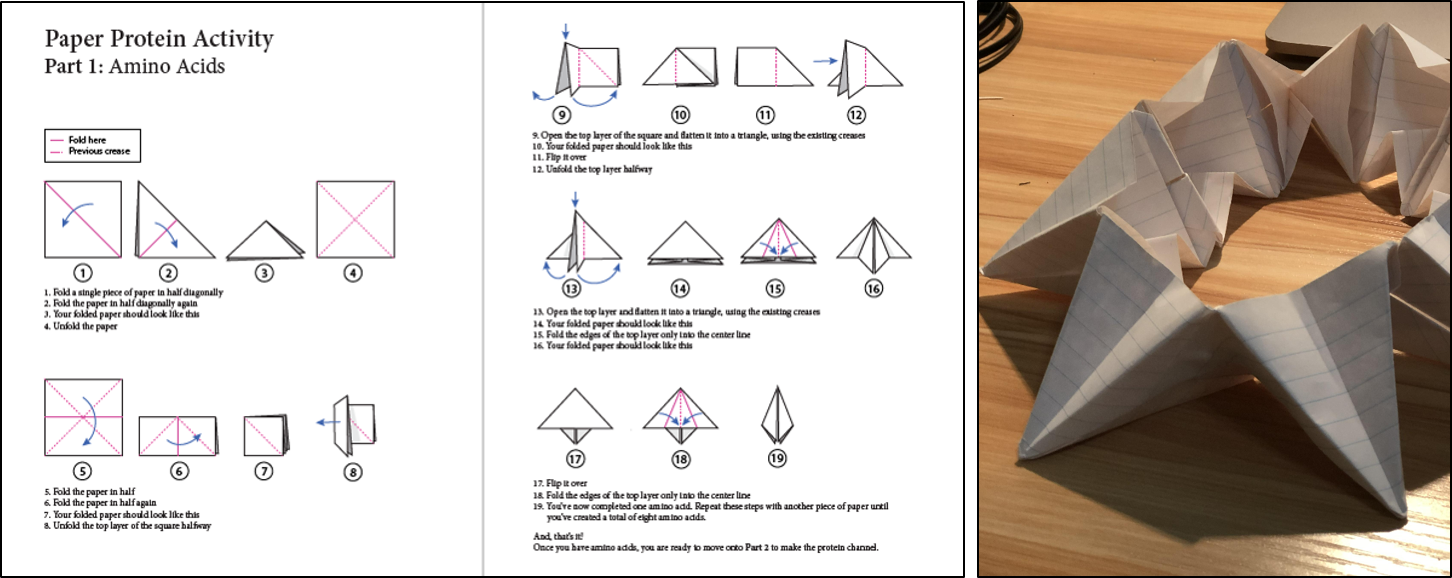
What types of activities do you offer students as they are joining your class session?
I have been providing a variety of pre-class activities including coloring themed images, topical crossword puzzles, topical anagrams, topical word searches, polls around outside academia experiences, origami amino acid building, word links, and alphabet topical words. I try to find something different as often as possible to keep things fresh and changed up for the students.

What prompted you to include these activities in your class sessions?
Because we are remotely synchronous, it just seems natural to try something to build community in our shared experience. I’m so curious to discover what interests students the most.
How have the students responded to these activities?
Students jump right in as soon as I open the zoom and post the activity 15-20 minutes prior to lecture. They spend a lot of time in chat with each other during the activity, as well. This makes me very happy as I can observe them building connection with each other.
What impact have these pre-class activities had on your course?
A lot of the impact has been on me, actually! I was very concerned about how many of the students expressed how lonely they feel being sequestered away from each other during the pandemic. Because this is a first year class, it’s particularly important to build connection and momentum with them so that they will maintain their excitement and interest in learning. I like to believe that the pre-class activities are helping them to feel as though they truly are an important part of our overall process.
What advice do you have for other instructors who are interested in using a similar activity in their own course?
Have fun with it! Try out different ideas to see what clicks with your students. This is a great opportunity to bond and build rapport with them – and even better, to gain insight from their lived experiences.
Is there anything else you’d like to share?
It’s my favorite part of building my synchronous class time! I feel as though these activities provide me with a way to connect with the students on a less formal level, and to offer them interesting insights that don’t fit readily into the material otherwise.
